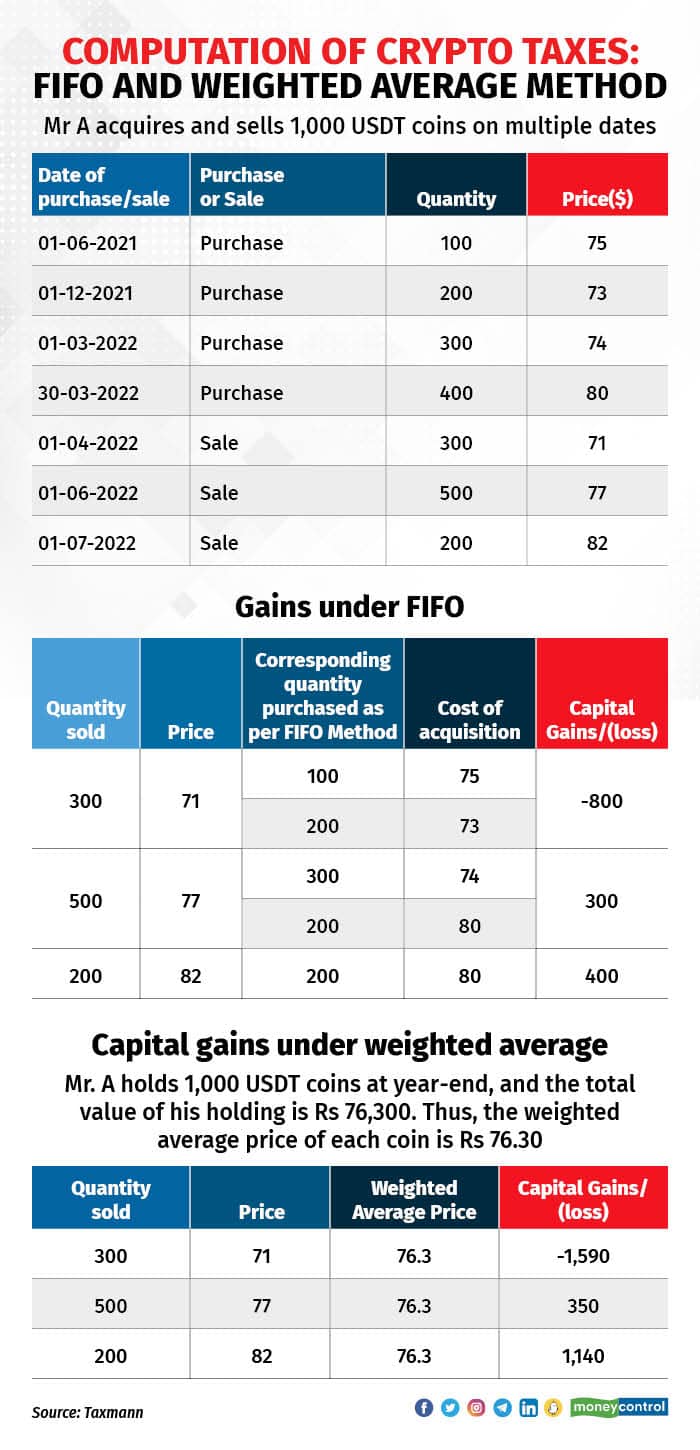



When they file their returns for this financial year, Indian investors will for the first time have to report crypto gains under the new taxation regime, which was introduced by the government in the Union Budget last year. However, experts feel that confusion still prevails over the method of computing tax on cryptocurrency gains.
March is usually the month when Indians look at last-minute tax-saving options. Some look at buying life insurance policies, some opt for the Public Provident Fund, while others choose tax-saving mutual funds.
However, no overall tax saving is possible in crypto investments.
The Finance Act 2022 had introduced Section 115BBH, which states that gains arising out of crypto assets are taxed at a flat rate of 30 percent. Further, losses from one crypto investment cannot be adjusted against gains from another and no carry forward of losses to future years is allowed.
In fact, an individual would have to pay taxes on gains arising out of the sale of one transaction of, let’s say, bitcoin, even if another transfer/sale of bitcoin had resulted in an equal or higher loss.Also read | Crypto, virtual assets to come under money laundering provisions
While computing the income from the sale or transfer of virtual digital assets (VDAs) or crypto assets, an assessee is allowed to only deduct the cost of acquisition.
We look at what the tax provisions applicable on cryptos are and whether investors can lower their tax burden.
Computation of taxes
In the case of securities held in demat form, a principle called FIFO (First-In-First-Out) is used to calculate capital gains.
According to experts, when it comes to calculating capital gains, the FIFO method is also recommended for all types of cryptocurrency transactions.
This method follows the principle that assets purchased first are sold first, while the assets purchased last are sold last. For instance, suppose you bought one ethereum coin in July 2021, and then bought two more ethereum coins in August. If you plan to sell two ethereum coins in September, the FIFO method would consider the first coin you bought in July and then one of the coins you bought in August.
Also read | Fuzzy future for Crypto tax filing firms
“This method is applicable for all cryptocurrency transactions, including buying, selling, or exchanging one cryptocurrency for another,” said Punit Agarwal-Founder KoinX, a crypto taxation platform.
A way to lower the tax burden?
According to the experts, if a person is regularly buying and selling VDAs, it is not possible to correlate the quantity sold with the quantity purchased.
“Section 115BBH does not provide any guidance on how such correlation should be made. Either he can follow the FIFO method or the weighted average method to compute the cost of acquisition of a VDA sold,” said Naveen Wadhwa, deputy general manager at Taxmann.
In the weighted average method, the cost of acquisition of the VDAs sold is the weighted average price of all his holdings at the time of sale.
“In the absence of guidance in Section 115BBH or similar clarification from the CBDT for the VDAs, the investor might take the position to use either the FIFO method or the weighted average method, whichever is more beneficial,” he added.
See image to check how crypto gains would be computed under different methods.

Confusion prevails
According to Amit Singhania, partner at Shardul Amarchand Mangaldas & Co., since there is no clarity over which method to use for tax computation, one should go for a correlation process.
“Suppose investors have sold a particular token, if they can correlate the token with the cost, they should follow this method for tax computation. One-to-one correlation to the extent possible is the right way to compute capital gains,” he said.
Further, some experts believe that lowering the tax burden is not possible in crypto assets.
Indy Sarker, co-founder of TaxCryp, said, “There is none, because it is on a transaction-by-transaction basis that your tax incidence is captured. If you really think about lowering your crypto taxes, then you trade as often, because the more you trade, you create more opportunity for positive tax, because every transaction in and out is a date-time stamp for capturing tax assessment or tax impact.”
What should taxpayers do?
In the absence of offset of losses and carry of losses, Indian crypto investors are now required to pay taxes annually with no way around. “However, investors can avoid paying additional taxes by accurately calculating their crypto tax liabilities,” said KoinX’s Agarwal.
Also read | This is going to be a do-or-die year for cryptos. Are investors prepared?
Experts feel that the real challenge is how seriously are people going to take their tax filings this year. Further, the government is also going to clamp down heavily, thereby driving tax compliance.
Given the lack of clarity over certain aspects of crypto taxation, investors would be better off taking a chartered accountant or tax portal’s help in filing their taxes for this year.
Discover the latest Business News, Sensex, and Nifty updates. Obtain Personal Finance insights, tax queries, and expert opinions on Moneycontrol or download the Moneycontrol App to stay updated!
Find the best of Al News in one place, specially curated for you every weekend.
Stay on top of the latest tech trends and biggest startup news.